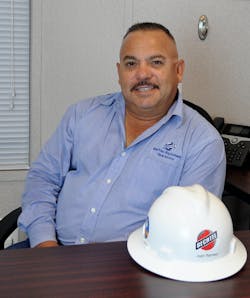The telematics system on a Caterpillar motor grader has an alert called “coasting into park.” What that means, says Juan Ramirez, Jr., CEM, equipment manager with Bechtel OG&C, is that the machine operator is “cruising into a stop” rather than bringing the machine to a complete halt and shifting it into park.
Reprinted with the permission of Equipment Manager magazine, the magazine of the Association of Equipment Management Professionals.
“We can go to the operator and stop him,” Ramirez says. That is the kind of data he needs to manage his particular heavy fleet applications. At the moment, his equipment is on a liquefication plant project in Gregory, Texas, about 12 miles from Corpus Christi.
Ramirez’s involvement with heavy equipment came at the early age of 16, eventually leading into a career that included combination mechanic for a company in Santa Ana, Calif., where he was promoted to various projects across the state as well as Texas and South America. He eventually became equipment superintendent for all of Latin America for Bechtel. As such, Ramirez was responsible for overseeing five major mine construction projects: two in Peru, two in northern Chile, and one in central Chile that included mining process plants.
The combined fleet of 2,500 units varied from 35-ton rough-terrain cranes, up to 400-ton crawler cranes, earthmoving machines, large trenchers, trucks, and small equipment. The fleet is mostly owned, with about a third of the units being third-party rentals, he says.
As equipment manager for Bechtel, a company he’s been with for six and a half years, his duties include writing specifications of heavy equipment and “helping the procurement team technically accept the equipment.”
“We inspect the units before we even buy them if used,” he says. “We maintain them on site. We do the fueling. We do the tracking of hours and PMs and reconfiguration of cranes.”
When telematics came on the industry stage stronger than ever in 2000, Ramirez says there were growing pains. “I started working with the telematics at that time, and by 2002 we had a good system functioning that gave us what we needed. Maybe not everything other fleet managers wanted, but it was enough for my needs at the time. It took me two years to get a good product that worked,” Ramirez says.
After that, telematics really took off, he says. A lot of vendors surfaced and “OEMs like John Deere and Caterpillar had their own telematics, but they weren’t used all that much back then,” he says. “Today, it’s an everyday tool.”
Measuring his individual comfort level, Ramirez says, “On a scale of 1 to 10 I am comfortable on number 8 simply because there is more room for improvement on certain brands. There are still some issues that go on. You also have to have good connectivity and good cell coverage—some kind of cell signal or Wi-Fi for them to work.”
Outstanding changes in the technology as they now stand have made a significant difference for him.
“Everybody has really gone their own way to kind of please their customers,” he says, “and even OEMs wanted telematics to tell them certain things that not all end users needed or wanted.”
Because of the new technology, a lot of the issues in the past have gone away.
One of the major developments that is going to continue to help out tremendously, says Ramirez, came last year when AEMP acted as the tip of the spear in driving efforts to create industry telematics standards.
“Now we have the same standards going forward. Now we are on track. This is one of the key changes and key benefits that have occurred. Going forward should be easier,” Ramirez says.
When OEMs came to the table, “it made it easier for us. As an equipment manager, I count on telematics and the technology behind it to manage my fleet, to make sure it is functioning properly, and to do my job properly. These are great tools to get your job as a manager done,” Ramirez says.
His partnership with dealers has worked well, he says, because of constant back-and-forth communication. Dealer feedback produces critical information, Ramirez says, explaining that dealers “are at the forefront in monitoring their equipment, receiving the alerts, and notifying us that something is wrong.”
The real benefit to the partnership is that the information received is real-time data.
“By having real-time data, you can become a real-time preventive maintenance department rather than a reactive one,” he says. “Another proactive approach is creating scheduled-ahead preventive maintenance intervals.”
The look-ahead approach lets you become a proactive PM team, not just putting out fires, he says. You know what’s coming, and you can prepare your people and the consumables that are going to be needed.
“Out here it is a rat race, and having a dealer partner makes it a lot easier in the management of heavy equipment,” Ramirez says.
Despite the improvements made in telematics and the real-time data that it produces, despite its significant leap forward in strengthening and refining even further the Equipment Triangle partnership, Ramirez says, a reluctance to use the technology still lingers among some fleet managers.
“Hopefully, I won’t offend anybody, but it is the older gentlemen who don’t care about it. I think the younger gentlemen in this business really embrace it,” says Ramirez. “It is the old-school type of guys who don’t want it. They get frustrated because of the connectivity and all the things it can’t do, the installation, and all that causes them to push back. But the partnering with an actual vendor that has this technology means telematics comes installed, it comes ready to go, and if you do have a problem the vendor will fix it for you.
“There are a lot of things that have changed since we first tried using the earlier versions of telematics, so I would encourage everyone still reluctant to telematics to take another look at it. It’s a very good equipment management tool.”
